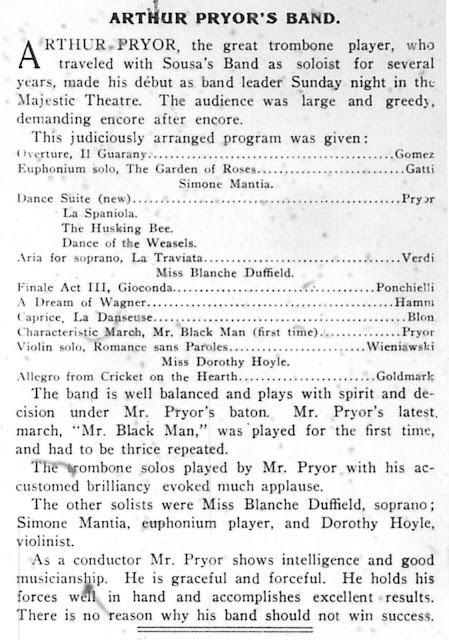As I shared in the
previous post, on August 9, 1903, Sousa's star trombone player for the previous 11 years, Arthur Pryor, announced that he was leaving that band and forming his own travelling ensemble. A mere three months later, on November 15, this new band played its debut concert at New York's Majestic Theatre on Columbus Circle (Broadway and 59th Street, which is at the southwest corner of Central Park).
The Majestic was not yet a year old, being scheduled to open at the very end of 1902, as reported by the November 23, 1902 edition of
The New York Times:
Interestingly, two of the headliners in the cast of "The Wizard of Oz" were Dave Montgomery and his comedy partner, Fred Stone, playing the Tin Woodsman and Scarecrow respectively. According to newspaper reports, Montgomery was born near St. Joseph, MO, and was reared, along with his brother Harry (later known as "Scamp" in New York's theatrical life), in the family of Sam Pryor, the father of Arthur Pryor! Consequently, Arthur and Dave were boyhood friends, and are found to have collaborated a number of times in their artistic endeavors over the years. Could it be that Dave encouraged Arthur to debut his band at the Majestic?
Here is a photo from those early months of the Theatre in 1903, where you can see "The Wizard of Oz" being promoted on various parts of the building (right above the front doors, and up on the far right, in front of the water tower on the roof):
The January 11, 1903 edition of
The Times ran a detailed article all about this spectacular new building that was just about to open, which I'll include in full here, just in case those details are of interest to you! The Theatre was indeed "a spick and span little place of amusement":
On May 21, 1903,
The Times shared that a new musical was in the works that would play at the Majestic: "Babes in Toyland," with the music written by Victor Herbert (who, from late-1894 to mid-1899, had been leading Gilmore's Band):
However, "The Wizard of Oz" continued to enjoy success throughout the summer and early fall, and "Babes" had to wait until mid-October for its opening night:
But somewhere in there, Pryor had made arrangements to debut his new band at the Majestic (again, perhaps his childhood friend, Dave Montgomery, encouraged him to use that venue), as reported in the November 8th edition of
The Times:
[Notice that there were "fifty pieces in the band." I'll come back to that below.]
That same day, the
New York Tribune ran the following advertisement for the Majestic, highlighting both "Babes" and Pryor's upcoming concert:
Here's a photo of the exterior of the building right around that time, showing the promotional signs for "Babes" on various parts of the building:
And here's a photo of the actual show on stage:
This brings us back to the image at the top of this post, which I'll include again here, so that you can compare the two photos of the stage:
The stage is clearly the same in both photos, as noted by the pit orchestra area, the bushy side walls, which must have been from the "Babes" set, and even the writing on the photos (it might be hard to make out, but both have white letters on the leading edge of the stage that identify the performance, and both photos were taken by the Byron Company of NY).
All of this confirms that this obscure photo . . . drumroll please . . . is
the very first photograph of Arthur Pryor's Band, from its debut concert at the Majestic Theatre on November 15, 1903!
This photo (and all of the photos of the Majestic above) has been quietly residing in the archives of the
Museum of the City of New York, where they have more than 300,000 images in their collection! And, as far as I can tell, they did not know that this particular photo of Pryor's Band is from its debut concert at the Majestic. The info that is provided with the photo on their website simply identifies the band, the photographer, and the year it was taken - 1903.
But now we know that it is a truly historic photo of this great band! How cool is that?!
Not surprisingly, the concert was a smashing success, with an audience that was "large and greedy, demanding encore after encore" (the account of the
Musical Courier, November 18, 1903):
Pryor went on to enjoy a long career as a bandmaster. Here's another account of the band's beginning, with a portait of Pryor thrown in for free, from
The Wilkes Barre Record, less than a month after the debut concert
(December 9, 1903):
[From my research so far, it appears that Pryor didn't end up "touring the country," as it says above. Instead, it seems that he regrouped, landed a few recording contracts, and didn't reappear with a band again until Easter 1904, and then for the entire summer at Asbury Park, NJ.]
What remains is obtaining a hi-res version of the band photo from the museum (I've requested one), so that I can examine more clearly the faces of the men in the band (there are in fact 49, plus Pryor, just as the notice said there would be), and confirm whether Herman Conrad is among them.
Stay tuned!
[
Many thanks to my good friend, Steve Dillon, of Dillon Music, who is the world's leading expert on Arthur Pryor. He was the one to share with me the link to this photo of Pryor's Band, and to tell me about Pryor's relationship to Dave Montgomery.]


























